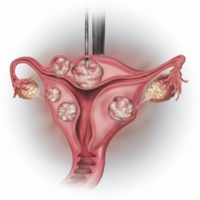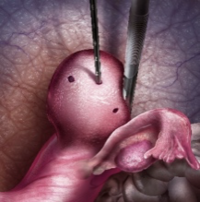If you suffer from these symptoms and have been diagnosed with uterine fibroids, you may be a candidate for the Acessa Procedure.
Dr. Kramer was the first physician to perform the Acessa Procedure in Tempe. This minimally invasive surgery has a shorter recovery time than other treatment options for fibroids.
Call 480-257-2700 to discuss your fibroid treatment options with Dr. Kramer today!
What is the Acessa® procedure?
The Acessa procedure is recommended for pre-menopausal women (typically younger than 55 years old)1 who are tired of living with the ongoing pain and discomfort of fibroids and are looking for a minimally invasive option that allows them to keep their uterus and return to daily life quickly after the procedure.1
The Results:
- 94% of patients responded that the treatment had been somewhat, moderately, or very effective in eliminating their symptoms.1
- Only 11% of patients required additional reintervention after the Acessa procedure.1
- 98% reported that they would probably or definitely recommend the procedure to their friends with the same health problem.1
The Acessa® procedure is also known as Laparoscopic Radiofrequency Ablation (LAP-RFA) and essentially delivers heat directly into a fibroid in order to destroy its tissue and in turn relieve your symptoms. The procedure contains 6 steps.2
- Prep – You are prepped and brought into the operating room for anesthesia.
- Access – Your physician makes three small incisions-one in your belly button - one below your bikini line - and inserts a tiny camera and ultrasound into each incision.
- Visualize – Your Physician precisely located each fibroid with the Acessa ultrasound probe and guidance mapping, allowing full view of your uterus.
- Deploy – Next, your physician deploys the tip of the Acessa handpiece into the fibroid while preserving healthy uterine tissue.
- Treat – The physician deploys controlled heat through the Acessa handpiece to destroy the fibroid tissue. The physician repeats this process until every targeted fibroid is fully treated. Once the procedure is complete, your physician stitches the small incisions on the skin.
- Recover – You will wake up in the recovery room. Most patients get cleared to go home within two hours. Women typically feel ready to return to work and daily activities after 4-5 days. In terms of when you will see symptom relief – this is a hot topic. It depends on how big the fibroid is and what symptoms you’re experiencing.
Acessa Procedure Risks and Considerations:
All treatment options for intrauterine pathologies have benefits, warnings, precautions, and risks. Before making a treatment decision, you should discuss these with your doctor. Rare but serious risks include, but are not limited to, skin burns, mild inter-operative bleeding, post-procedural discomfort (cramping, pelvic pain), infection, vaginal bleeding, blood loss and complications related to laparoscopy and or general anesthesia.
Insufficient data exists on which to evaluate the safety and effectiveness of the Acessa ProVu system in women who plan future pregnancy, therefore the Acessa ProVu system is not recommended for women who are planning future pregnancy.


Animated video about procedure
Sources:
- SG Chudnoff, et al. Outpatient Procedure for the Treatment and Relief of Symptomatic Uterine Myomas. Obstetrics and Gynecology, 2013;121(5):1075–82.
- The Acessa procedure ProVu Instructions for Use, ProVu Users Guide PL-01-0040
“Frequently Asked Questions”
Who is this procedure for?
The Acessa procedure is recommended for pre-menopausal women (typically younger than 55 years old)1 who are tired of living with the ongoing pain and discomfort of fibroids and are looking for a minimally invasive option that allows them to keep their uterus and return to daily life quickly after the procedure.1
What size, location, and types of fibroids can Acessa treat?
Size and location of fibroids are important factors in what procedure is right for you. That’s why physicians do an MRI or ultrasound prior to determining if you are a candidate for the procedure.
The Acessa procedure has been studied on fibroids up to 7CM,.2 The procedure can be used to treat most types of symptomatic fibroids, including subserosal, intramural, transmural, and certain submucosal.1
How does Acessa compare to other common fibroid treatment options?
Vs. Hysterectomy – The Acessa procedure allows you to keep your uterus and has a quicker recovery time than a hysterectomy. However, hysterectomy is a definitive treatment, so after recovery, there is no chance fibroid symptoms will return.
Vs. Myomectomy – Myomectomy cuts fibroids and surgically removes fibroid tissues from the uterus. The Acessa procedure, by comparison, does not require cutting or suturing within the uterus.2 Myomectomy may be considered a minimally invasive surgery because incisions into the abdomen can be small. The Acessa procedure may be a less invasive option because there are zero incisions on the uterine surface (serosa) that require suturing, and only 3 small incisions on the skin (myomectomy typically requires 4 to 6 incisions in the skin).
Vs. UAE - UAE involves ischemic necrosis which consists of the tissue slowly dying due to lack of blood supply and typically involves an overnight stay for pain management.3 The Acessa procedure uses coagulative necrosis which destroys the fibroid cells and nerve endings with heat and results in the reduction of the fibroid volume over time.1,4 After the Acessa procedure, patients typically return home the same day. UAE is performed by interventional radiologists. The Acessa procedure is performed by minimally invasive gynecologic surgeons.


How does the procedure work?
- The clinical terminology for the procedure is Laparoscopic radiofrequency ablation (Lap-RFA) for fibroids.
- The Acessa procedure is an outpatient procedure, and patients generally go home the same day, on NSAIDS.1
- The Acessa procedure works by heating the fibroid cells using radiofrequency ablation. The treated fibroid cell shrinks overtime, ultimately resolving fibroid symptoms.1





- The change in the consistency is what creates the relief from the fibroid symptoms.4,5
- The treated fibroid tissue is not harmful, and typically gets reabsorbed into the body.2
- The Acessa system handpiece is designed to treat only the fibroid tissue and does not require suturing to the uterine lining. As a result, the healthy uterine tissue around the fibroid is left intact.4
Are there external scars?
There are a minimum of three incisions, one in the belly button, one above the bikini line, and one small incision that does not typically leave a scar by the bikini line.
Where can I learn more?
Click here to learn more about the Acessa procedure.
I’m interested, what’s next?
Call 480-257-2700 to discuss your fibroid treatment options with Dr. Kramer today!










